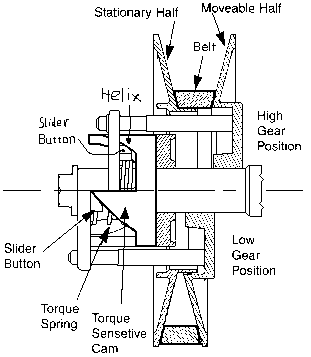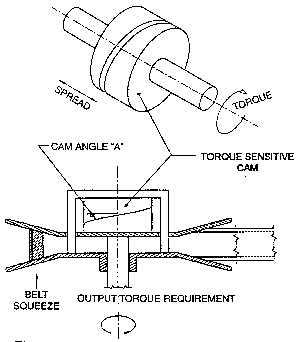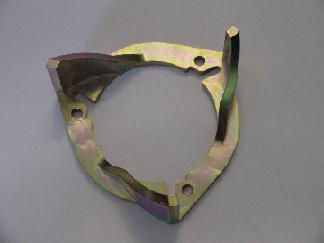

http://www.gates.com/
- The secondary clutch is harder to explain and understand than the primary, but I'll give it a shot..
- At idle and slow speeds, the belt is out near the outer radius of the clutch. As vehicle speed increases and the primary uses more of the belt, the belt gets pulled into the secondary, spreading the sheaves apart.
- Included in the secondary is a helical shaped ramp (see picture below) called a helix (called a torque sensitive cam in the diagram above) and a torsional spring. The purpose of these items is to oppose the spreading motion and to squeeze the belt so that the frictional force increases and keeps the belt from slipping.

Taken from Super Torquer Systems Inc
http://www.supertorquer.com/
- The moveable sheave does not simply spread apart as it does in the primary; instead it rides on the helix on either slider buttons or rollers and twists as it moves out. This is a torque sensing feature that "senses" the load on the track. When the track is lightly loaded, as was the case in the movie, the secondary shifts sooner and there is a small frictional force on the belt, but that is ok because it is unlikely that the belt will slip with a light load. This is very much like an automatic transmission in a car. Going down hill, the car will shift at a lower rpm because there is a small power requirement. However, when going up hill, the car will go to a much higher rpm before shifting because there is a large power requirement. Going back and forth between this and the above diagrams should help you to understand the secondary.
- The torsional spring, like the helix, also resists the spreading force. The spring also brings the clutch back to low gear when the throttle is let off by pulling the moveable sheave back up the ramp (helix).

Image taken from http://www.snowest.com/
If this page confused you too much, hopefully the next page can bring it together a little bit for you.
Or you can give up now and go back to the home page.